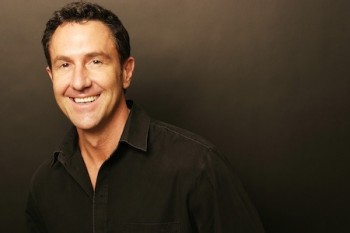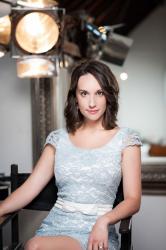An afternoon with Brett Sheehy, Melbourne Festival’s Artistic Director
AussieTheatre.com’s Editor Erin James chats with Melbourne International Arts Festival Artistic Director, Brett Sheehy.

I have to admit this right here, right now. I’ve never been to one of Australia’s big Arts Festivals. There, I’ve said it. Let the shaming begin.
Seriously though, being a girl from ‘that coal town’ Newcastle, I have never really understood the ‘Festival Fever’ which sweeps the big citites around International Arts Festival time.
Last week I spoke with Brett Sheehy, the Artistic Director of the Melbourne Festival, and after an in depth discussion I must say I have been converted – everything about an international arts festival appeals to me; the inclusion of new and innovative works from across the globe, the access which an entire city gains to world class art, music, theatre and dance during the festival. I’m sold. I’m in. Hook line and sinker.
After explaining to Brett my naivety regarding the Melbourne Festival, he laughs: “Well, I am not a Melbournian by birth, but I’m sure I can help you out with anything you need to know.”
A fact of which I was absolutely certain. Here is a man who has sat at the helm of 3 International Arts Festivals in Australia (Sydney Festival 2002-2005, Adelaide Festival 2006-2008 and Melbourne Festival 2009-2012), has worked for the Sydney Theatre Company for 10 years and is soon to take over the job of Artistic Director of the MTC in November next year.
Here is a man who has lived and breathed the Arts for as long as I have been alive. Of course he can help me out with anything I need to know…
Brett Sheehy – a brief history…

“My first job in the Arts was with the Sydney Theatre Company. I had studied dramatic text, not performance at uni, but I got a job at the STC as a gofer for the directors there – you know getting their coffees, photocopying, whatever – and then I ended up staying at the Sydney Theatre Company for 10 years.”
During his 10 years at the STC, Sheehy held the positions of ‘Gofer’, Artistic Associate, Literary Manager and finally Deputy General Manager.
“Then, in 1995 Anthony Steele, the guy who was director of Sydney Festival, called me up and said ‘how’d you like to come and work at the Festival?’ I’d never thought about it before, but after 10 years in theatre I became his Deputy Director”, Sheehy said.
Sheehy worked at the Sydney Festival as Deputy Director under Steele for 2 years, and later under Leo Schofield for 4 years before becoming Director himself. These 6 years he calls his “apprenticeship” in delivering Festival visions:
“I’ve had the luxury and privilege of working on Festivals now since 1995, (that’s a hell of a long time!), and I have learned the science and the mechanics of putting a programme together and producing work: I had a great opportunity with these two men”, he said.
Artistic Direction
The 2011 Melbourne International Art Festival, which is set to begin on October 6, is Sheehy’s 10th Festival as Top Dog, and it is perhaps his understanding of Artistic Direction which has helped him stay in the hot seat for so many years.
“Artistic Direction is having an artistic vision for an organisation and expressing that vision to an audience” he said.
He explains that the job of curating works for a Festival is an ongoing one which he has been building connections for his entire career – be it knowingly or not.
“I’ve been travelling internationally for work every year for nearly 27 years. I have a network of artistic connections, other producers and festival directors whose visions I trust”, he said.
The process of selecting works for a Festival is more than meets the eye: a Festival features numerous art forms, so he is programming not only theatre, but art, music and dance.
“I have this back catalogue in my rolling shortlist, which tends to contain about 500 projects”, he explains.
“Each year from that 500 it shakes down to the final 60 works which will appear in the festival programme. The remaining 440 are put in the mix for the following year”, he laughed, also explaining that another 100 or so will present themselves along the way.
Of the 60 works appearing in this year’s Festival, Brett has seen them all. All but the world premieres, that is, but as he says:
“Even those, I have seen (or heard, in the case of a musical concert) in workshop form.”
That’s a lot of Art for one bloke to digest – thankfully, he is up for the challenge.
Curating a Festival
I quizzed Sheehy on his methods in choosing the final 60 works to appear in the final line up. The way he spoke about his Top Picks of the Festival gave me the distinct impression that he was not simply passionate about Art for Art’s sake, but about the messages it brings to its audiences. Curating a festival programme is not just about art, but about the state of the world at the time of curation.
“No credit to me – all credit to the artists themselves”, he said. “I’ve never ever pre-themed a festival in the sense of saying ‘ok, let’s do this festival about a particular issue’. I get between 12-15 submissions a day – and what that gives me is a really clear idea of where the artistic world is sitting. I can see that around the world, there are general themes and issues emerging.”
He insists that it’s not hugely scientific, emphatically stating that “people are people all over the world”, and great art will connect with an audience in Beijing, as well as an audience in Johannesburg as well as an audience in Melbourne.
“Now in a post 9/11 world, in a global warming world, in a world where there are images of acts of terror on our computer screens and televisions 24/7… of course artists are going to respond to that. And they are responding massively and magnificently”, he said.
“The art world tends to marinate ideas for a period of time. What that lends to the work is a wonderful universality”, he said.
Now, a decade later, a lot of political art is emerging about the decisions made around 9/11, and the arts are stronger for it. When viewing theatre and art, Sheehy tends to trust his gut feeling, rather than over analysing the work.
“It’s an instinctive reaction. There is so much great art out there in the world, but I suppose what ends up being in my festival programmes tends to be the work which engages me not only intellectually, but also emotionally. I sit in the theatre and it physically kicks me in the chest. I become almost desperate to present these works to our audiences”, he said. With no personal artistic agendas, Sheehy believes he is completely open to all kinds of incredibly diverse work: “It’s not so much ‘will Australian audiences like this?’, it’s much more ‘does this work connect with me’, and if it does, I’m pretty confident it will connect with audiences in Australia too”. “It’s as simple as that!”, he laughs.
Where to from here?
This intensely complex and intelligent man has one more year as the Artistic Director of Melbourne Festival before making an unprecedented move to become Artistic Director of the MTC. Unprecedented because it will be the first time a non-practicing director of plays has ever led a state theatre company.
“I’m interested in what that will free up in terms of creative processes”, he said.
He hopes that accessibility to MTC by artists who are not now inside the theatre loop will be greater, and that his approachability will allow artists to “feel more confident in bringing ideas and projects to me”.
He also believes that not being locked away in a rehearsal room, directing plays for a significant chunk of each year will also afford him the opportunity to be “a hands on producer of all of the work we present at MTC.”
“I will be there to facillitate and to help the artists who are directing the plays just to help them 24/7 in realising their vision to the greatest possible potential”, he said.
Although Sheehy worked for 10 years at STC as part of the artistic team, he has been away from the state theatre company scene for nearly 17 years.
I asked him about the shift from Festival to Theatre Company and he made some interesting comparisons between the two.
“The first is that a festival is multiple art forms. At MTC, it will primarliy theatre” he said.
However, it is evident that Sheehy is very interested in broadening what theatre now means in the 21st century.
“People who are making theatre are drawing from all sources, especially young theatre makers”, he said.
This is, for him, the most exciting thing about what Sheehy describes as my generation of theatre makers in the 21 century. He seems completely enamoured by artists’ preparedness to “dismantle the barriers around art forms which have created inaccessibility”.
He believes that these barriers have restricted artistic vision. Barriers around opera and classical music which have been impenetrable to people are being torn down, and he is rejoicing in this fact.
“MTC core work will be text based theatre”, he admits “but I’m really interested in pushing the boundaries and exploring what defines theatre.”
The Festival in Physical Form
Those in Melbourne will be aware of the Melbourne Festival marketing campaign which is sweeping the city in the lead up to October 6. With the purple and white colour scheme, I’ve no doubt you have seen the images of giant cherub sculptures on posters, billboards and trams? These cherubs will be visiting Melbourne for the duration of the festival from Lille, France and according to Sheehy will demand attention:
“I love doing public artwork where I can in festivals. It gives the festival a very physical presence in the street. In Melbourne, there is no-one who will enter the CBD in October and not know the festival is on”, he said.
The seven post apocalyptic sculptures, ranging between 5 and 7 metres in height, will be positioned around the CBD and despite their dark undercurrent, they have a cheeky and playful edge.
“Everyone from kids right through to the high-art world just adore them”, he assured me.
The sculptures are going up overnight on October 5, so wheen the festival begins on Thursday, 6 October, Melbourne will have seven new friends. If you are in Melbourne between October 6 and 22, make sure you check out the Melbourne International Arts Festival.
There is an iPhone app available, so you can plan your festival events in the palm of your hand, and there are so many incredible work on show – there is certainly something for everyone at this carefully programmed event. To the wonderful Brett Sheehy – thank you for opening my eyes to the delightfully deep and fantastically fun world of International Arts Festivals, I promise I won’t miss one again!
Further reading:
Artistic Picks: Brett Sheehy’s Top 3 Picks for the Melbourne International Arts Festival 2011 Melbourne Festival in the palm of your hand: iPhone app released


